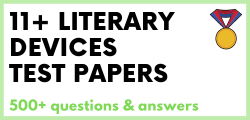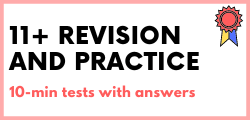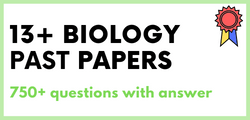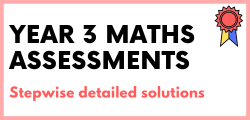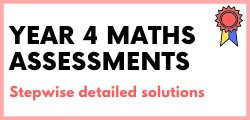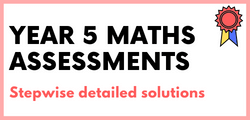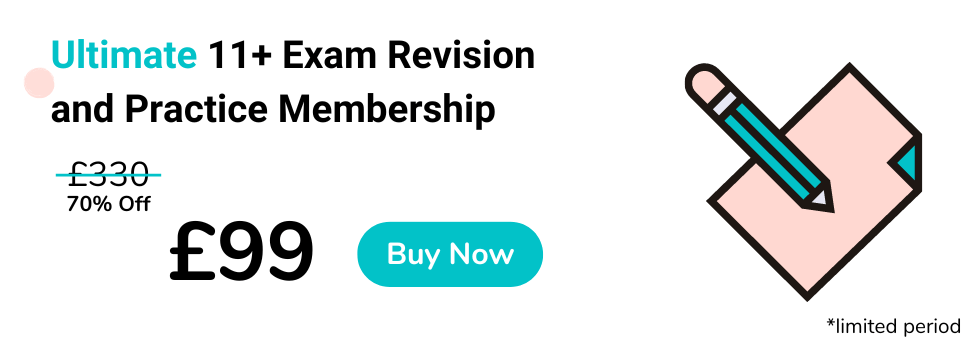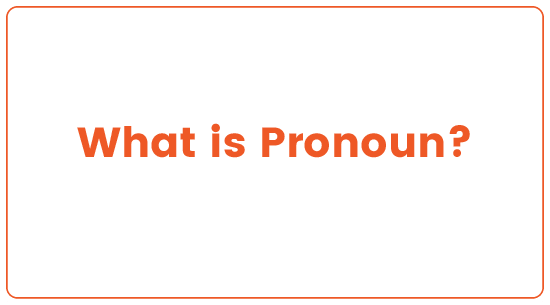
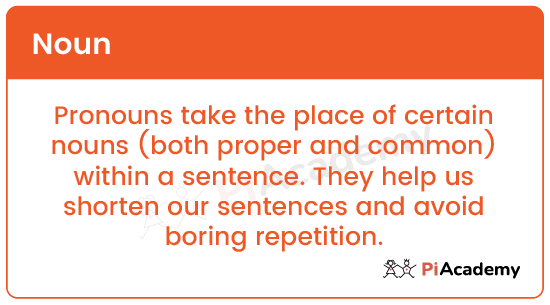
Let’s Understand What is a Pronoun and Explore Different Types of Pronouns with Examples.
Pronouns take the place of certain nouns (both proper and common) within a sentence. They help us shorten our sentences and avoid boring repetition. Follow our easy-to-use guide to help you construct sentences using pronouns!
Examples of pronouns in sentences:
- Tonya went to the store and she bought some milk. In this example, we are replacing Tonya’s name to avoid repetition. The noun that is replaced by the pronoun is called an antecedent.
- My children went to see the movie, but they didn’t enjoy it. In this example, we do not need to repeat ‘my children’, so we can replace the phrase with ‘they’.
In English, we use nouns to indicate subjects, direct objects and indirect objects within a sentence. As pronouns can be used to replace nouns within sentences, they can be used as subjects or objects.
Pronouns as Subjects
All sentences will have a noun or noun phrase as a subject. The subject is the place, person or thing that drives the verb in the sentence. If we replace the noun with a pronoun, it can behave as the subject in sentences. Subject pronouns include I, he, she, we, they, you and who.
Example of a pronoun as a subject:
- The dog wanted to play. He chased the ball.
The dog is the subject of the sentence as it is the thing that actions the verb. The replacement of the subject with the pronoun ensures that it is still the subject of the following sentence.
Other examples of pronouns as subjects:
- I visit the cinema on a weekly basis.
- He won the race.
- She took the first roll of the dice.
- We chose to have pizza for dinner.
- They chose to take a day trip to Yorkshire.
- You would like this book.
- Who would like a cup of tea?

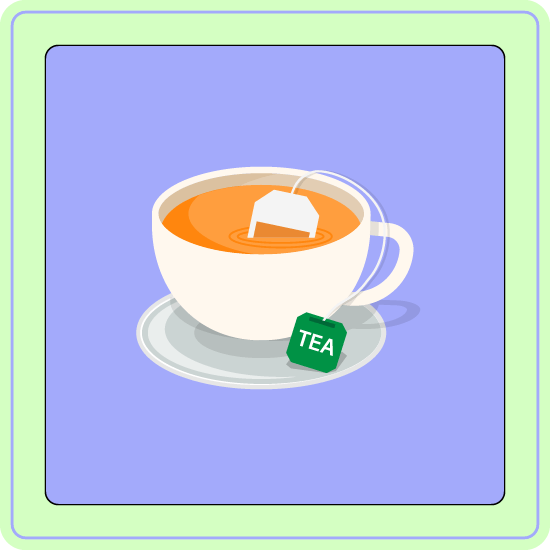
Pronouns as Objects
Nouns can also be an object of the verb in sentences. If we replace the noun with a pronoun, it can behave as the object in sentences. Object pronouns include me, him, her, us, them, you and whom.
Example of a pronoun as an object:
- The dog chased the ball (the ball is the direct object). He caught it (the replacement of the ball with the pronoun ensures that it remains the direct object).
Other examples of pronouns as objects:
- Sarah described the man to me.
- I am very grateful to him.
- I like her.
- Shall we show them the proposal?
- Give the ball to us!
- I will find that information out for you.


How Many Types of Pronouns are There?
There are many different categories of pronouns. As mentioned earlier, we can represent both common nouns and proper nouns using pronouns. The most common types of pronouns are possessive, personal, relative, indefinite, demonstrative, reflexive, intensive, interrogative, reciprocal, and distributive.
What are possessive pronouns?
Possessive pronouns are used to indicate possession of something. They replace possessive nouns within sentences. Possessive pronouns include yours, mine, its, his, hers, ours and theirs.
Examples of possessive pronouns within sentences:
- Could you take this bag to the people on table five as I think its theirs.
- Have you seen this cat around the village? It’s mine.

What are personal pronouns?
Personal pronouns replace the proper name of someone. Personal pronouns include you, he, she, I, we, they, me, him, her, them, us and it. While we typically use them to replace the names of people, we can also use them to refer to animals, inanimate objects and even concepts. They can be either singular or plural.
Examples of personal pronouns within sentences:
- You should try this recipe!
- I think he likes the way she looks.
- I think we should meet up soon.
- They would like us to meet up with them soon.
What are relative pronouns?
Relative pronouns are used to replace nouns within complex sentences. They are used to connect a dependent clause with an independent clause. Relative pronouns include who, whom, which, that and whose.
Examples of relative pronouns within sentences:
- I once had a pen-pal and exchange partner who lived in Japan (the independent clause is connected by ‘who’, as we are referring to the subject of the sentence).
- The family with whom I stayed were very welcoming (the independent clause is connected by ‘whom’, as we are referring to the object of the sentence).
- I kept all the letters which my pen-pal sent.
- The land that her family owned was huge!
- She had a father whose origami skills were amazing!
What are indefinite pronouns?
Indefinite pronouns are used to refer to people or things without being specific as to who or what they are. Indefinite pronouns include anybody, anyone, anything, everybody, everyone, everything, nobody, no one, nothing, somebody, someone, and something.
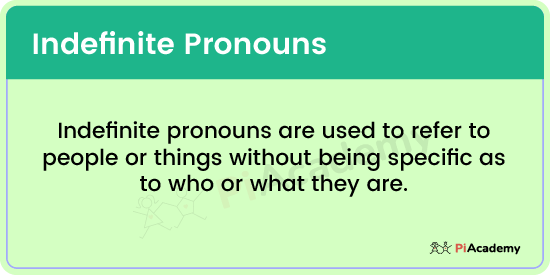
Examples of indefinite pronouns within sentences:
- Is there anything I can help you with?
- Is anyone there?
- My children are everything to me.
- I am waiting for someone to serve me.
- Would you like something from the dinner trolley?
What are demonstrative pronouns?
Demonstrative pronouns are used mainly to refer to things that we need to highlight. Demonstrative pronouns include this, that, these and those.
Examples of demonstrative pronouns within sentences:
- I am really enjoying this book.
- How did you achieve that high score?
- These are my kittens.
- Those flowers look beautiful in that vase.

What are reflexive pronouns?
Reflexive pronouns are used to refer to a noun or a pronoun used elsewhere in the sentence. Reflexive pronouns include myself, yourself, himself/herself/itself, ourselves, yourselves, themselves.
Examples of reflexive pronouns within sentences:
- Could you tell me a little bit about yourself?
- He made the meal himself.
- She isn’t feeling herself.
- They should all be proud of themselves.
What are intensive pronouns?
Intensive pronouns are very similar to reflexive pronouns but are not necessary to complete the sentence in a semantic sense. Rather, they are used for emphasis.
Examples of intensive pronouns within sentences:
- I love Elton John, so I have booked to go to see the man himself!
What are interrogative pronouns?
Interrogative pronouns are used to replace nouns when asking questions. They are often referred to as the ‘wh-words’. They can be used to represent the subject or object within a sentence and can also take the form of a possessive noun.
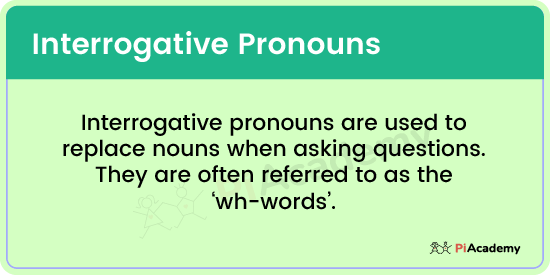
Examples of interrogative pronouns within sentences:
Subject: Who made this mess?
What did you do?
Object: Which of these cakes was your favourite? (direct)
To whom did you give the cake samples? (indirect)
Possessive: Whose coats are these?
What are reciprocal pronouns?
Reciprocal pronouns are used to express a dual or mutual relationship or action within a sentence. Reciprocal pronouns are each other and one another. As a general rule, If you are referring to two things or people, use the reciprocal pronoun each other and if there are more than two, use one another.
Examples of reciprocal pronouns within sentences:
- We love each other.
- They all support one another within the team.


What are distributive pronouns?
Distributive pronouns are used to refer to members of a group or class and are usually followed by [of + pronoun].
Examples of distributive pronouns within sentences:
- All [of them] have chosen the same pizza topping.
- Each [of us] will have a chance to score a goal.
- Neither [of them] will go to that restaurant again after that terrible experience.
Sneak Peek of PiAcademy Resources
Now that we have explored pronouns in detail, why not try out our practice papers and exercises on our website!
















